Individuals
Moving to Mexico from the US: An Expat’s Complete Relocation Guide
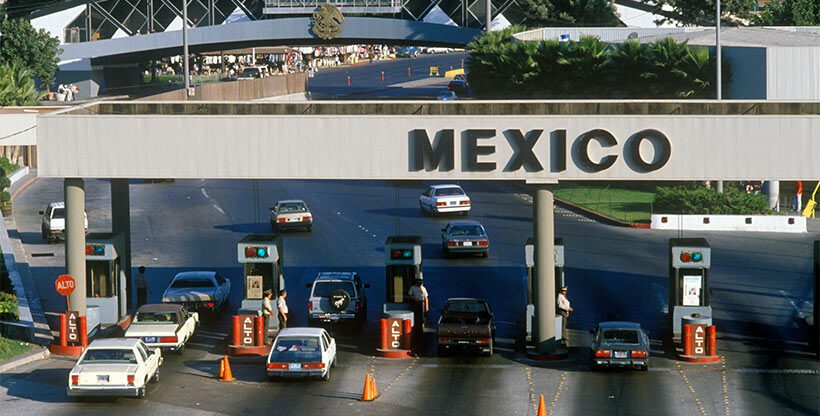
Nearly nine million Americans live abroad, not counting the military, and Mexico is one of the most popular destinations for expats. The prospect of relocating to a foreign country is exciting, but the logistics of moving yourself to Mexico, household and all, may feel overwhelming. No worries—we’ve got you covered! We will guide you through the relocation journey, from start to finish, from the planning stages, up to moving day.
How to Move to Mexico?
This guide tackles logistical issues, one by one, addressing common questions and concerns about safety, visas, taxes, and the best places to live, along with plenty of helpful tips to make your transition to Mexico painless.
You might need to refer to this article at several stages of the relocation process, so this table of contents could be helpful:
Is It Safe for Americans to Move to Mexico?
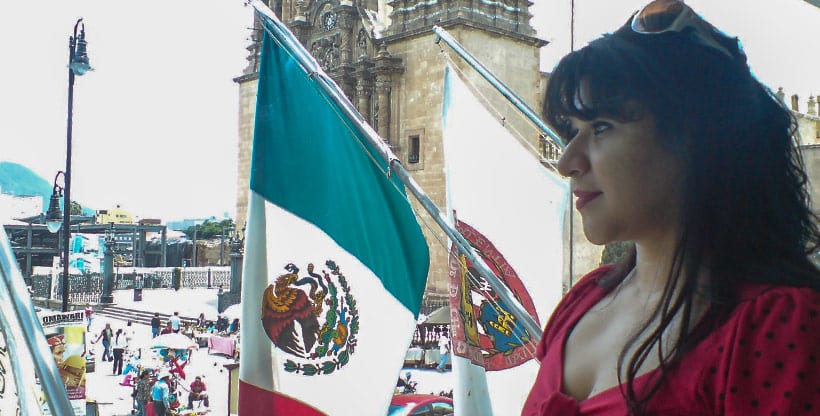
For many, this is the first question that arises when considering a move abroad. Leaving your home country is a leap of faith into the unknown, which is often scary, but that fear can be tempered with a little research. Like the U.S., Mexico has pockets where crime and violence are higher, and conversely, areas where it’s lower. So, in short—yes, there are plenty of safe places for expats to live in Mexico!
Later, we will list 10 cities which are widely regarded as the safest in Mexico, a claim backed by a safety index which is calculated mostly on crime statistics. Please note that while these locations are largely considered safe from violence, petty crime such as scams and pickpocketing are still a risk, and common sense should be exercised. The U.S. State Department regularly posts travel advisories online and is a great resource for the most up-to-date safety information.
What Draws Expats to Mexico?
Each U.S. citizen moving to Mexico has their own reason for pursing a life abroad—some are drawn by a sense of adventure. Others want a perpetual summer, and many are looking to stretch their dollar further. Mexico offers all that, so it’s easy to understand why Americans make up over half the country’s immigrant population.
Adventure
Moving south of the border to immerse yourself in a new culture is the thrill of a lifetime. Expats will undoubtedly experience an entirely different sensory world with markedly different sights and sounds. While exciting, it is certainly a step outside the comfort zone, so it helps that Mexican culture is widely reported as warm and welcoming to Americans.

Expats seeking excitement will find many aspects of the culture to enjoy including spectacular national dishes, learning a new language through full immersion, and exploring Mexico’s history, including well-preserved ancient Mayan temples and colonial-era architecture.
For those who enjoy the outdoors, Mexico offers a bit of everything: caves, cenotes, waterfalls, high mountains, low canyons, cactus-dotted deserts, lush rain forests, and 5,000 miles of coastline to surf, scuba, snorkel, and spot marine life.
Climate
Many associate Mexico with hot, dusty deserts or palm-lined beaches, but Mexico’s landscape is highly diverse which means its weather is too. Climate depends on altitude and latitude, or the distance from the equator, and Mexico offers something for everyone in that regard.
For those who prefer sun and higher temperatures, consider a beachside location or the deserts of the north. For a temperate climate characterized by mild temperatures, look to the central highlands, such as Mexico City, San Miguel de Allende, and Puebla.
There are even “tierras frías” in Mexico, or cold lands, which sit at an elevation of 7,500 feet or more above sea level. These areas tend to be sparsely populated, so relocation may not be ideal or possible. However, you may be able to tour these areas and even take part in winter sports at Monterreal Ski Resort, located an hour and a half from Monterrey.
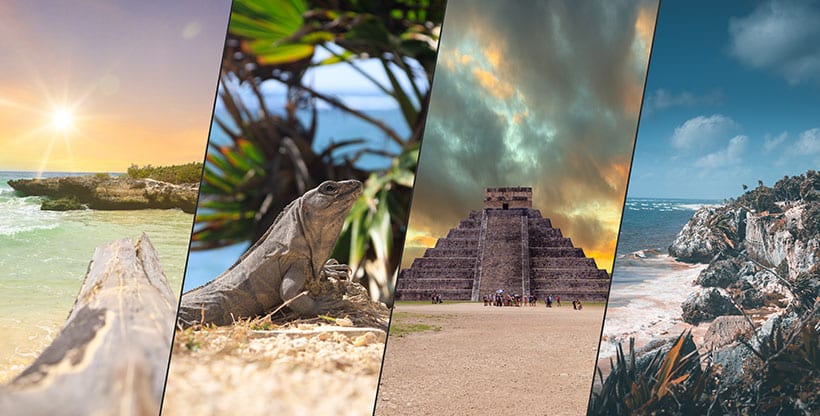
Cost
If the scenery and weather don’t speak to you, your wallet might. In Mexico, your dollar goes twice as far. Literally. According to cost-of-living database, Numbeo,
“Living in Mexico is, on average, 50.48% lower than in the United States.”
Rent for a one-bedroom apartment in an average city center is $432 USD and $771 USD for a three-bedroom.
Aside from rent, Numbeo estimates a single person can live comfortably on an estimated monthly budget of $469 and a family of four would be $1,694. For retirees living on a fixed income, this is especially appealing, as the peso is consistently lower against the U.S. dollar, providing assurance for future stability.
How Do Visas Work for U.S. Citizens Moving to Mexico?
This a general guide for Americans obtaining Mexican visas. Please be mindful that immigration rules are subject to change. Always verify the latest requirements with your destination country while planning your relocation to prevent being blindsided.
In most cases, you will need a passport to visit Mexico. Learn how to apply here.
Visitor Visas
Unless you’re familiar with Mexico, a visit is prudent before deciding to settle permanently. Visiting U.S. citizens are permitted a maximum of 180 days (about 6 months) in the country, but travelers are not guaranteed the entire six months. The time that travelers are permitted to stay is at the discretion of the official granting your entry.
If you love Mexico and decide to stay, make sure you do the necessary paperwork to obtain a temporary resident visa, as the visitor permit is not eligible for renewal or extension. You must leave the country when it expires.
Historically, many expats who moved to Mexico relied on getting the full six months every time, and others have used “border runs” to renew their stay, exiting and re-entering Mexico in short order for the purpose of gaining another six-month visa. This is not advisable as a long-term solution. If your passport shows you are a perpetual visitor, it may cause issues with Mexican immigration authorities, including the risk of denied entry.
Temporary Resident Visas
This visa permits you to reside in Mexico up to four years, but you must prove that you are financially solvent, meaning you have sufficient funds to sustain yourself while living in Mexico.
According to the Mexican Consulate’s website, proof of economic solvency qualifies as one of these two options:
“bank accounts with a balance of approximately $41,159.52 US Dollars during the previous 12 months”
“a job or pension that yields a monthly income of $2,107.37 US Dollars after taxes during the previous 6 months”
Temporary resident visas are initially issued for one year but can then be renewed in increments of one, two, or three years. This visa also permits work, though it’s not guaranteed. Border crossings are unlimited, so you can travel to and from Mexico as much as you like without hassle. Just be advised that the number of days you spend in the U.S. can have a drastic bearing on the taxes you pay. See the tax section below for more details.
Permanent Residency
So, you love Mexico. You’re ready to take the plunge and move. What’s the next step? After four years in Mexico under a temporary resident visa, expats may apply for permanent residency. Visa rules and stipulations are listed on the Mexican Consulate’s website.
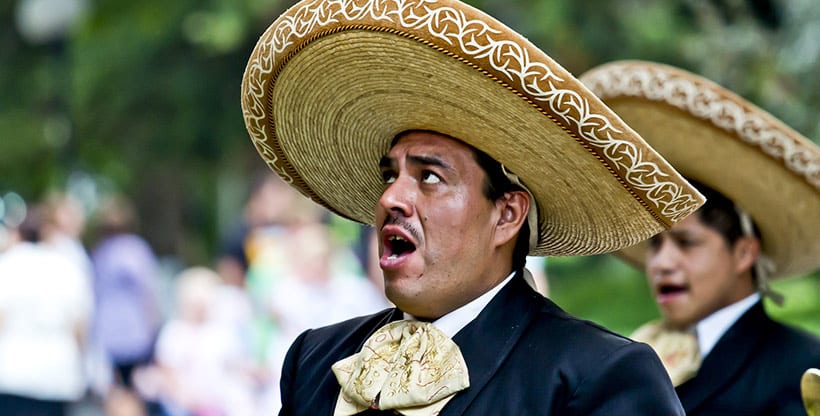
What Should Expats Consider Before Moving to Mexico?
Language
Another common concern for those considering a move abroad is the language barrier, but don’t worry! English is fairly prevalent in Mexico, and translation apps can help you fill in the gaps.
While you can likely get by without knowing a word of Spanish, learning it is a good idea. Not only will it empower you and help you feel connected to your new country, but your efforts to speak the local lingo—even poorly—will build goodwill. You may be surprised at what you can learn studying as little as 15-20 minutes a day on a free language-learning app, such as Duolingo. The app has reminders to keep you accountable!
Because expats are immersed in the language and culture, the learning landscape for expats is different than the average student, and they need to learn the language quickly and efficiently. Read this guide to identify your learning style and find advise on how to use it: Using Learning Styles to Help Expats Learn a New Language Quickly
Education
American expats moving to Mexico with school-aged children have three main options regarding education: public schools, private schools, and homeschooling.
Public Schools
Expatriate children are welcome to enroll in Mexico’s public schools; however, it’s worth noting that Mexico’s public education system consistently ranks low on quality indexes from organizations such as the Organisation for Economic Co-operation and Development (OECD). The school systems have long suffered from chronic underfunding, and rural areas have been especially impacted. Also, children attending public schools must speak Spanish, as there is no support for secondary languages.
International or Private Schools
International and private schools are paid options that provide a quality education which prepares students for college.
Homeschooling
Parents who choose to homeschool may play teacher themselves or delegate the task to companies specializing in remote education. There are many affordable homeschooling options to choose from, and this article from homeschool.com provides a good starting point for expat parents exploring their options.
Income
If you can’t sustain yourself off savings and need an income, expats in Mexico typically rely on remote work or getting a job locally.
The digital nomad lifestyle has increased in popularity in recent years with the rise of telework, enabling people to earn income online anywhere in the world. Assuming your company doesn’t prohibit you from working in Mexico, this is a viable option. Currently, there are no visas specifically for digital nomads, as some countries, like Italy, have, but you can enter Mexico on a visitor’s visa.
If you plan to stay for an extended period, it’s smart to apply for a temporary resident visa. Though visitor visas are typically granted for six months, it’s not guaranteed, and your visa length is at the immigration official’s discretion. Plus, temporary residents have the privilege of unlimited border crossings.
Temporary resident visas will be required if you plan on pursuing employment in Mexico, and it must come with work permission. Many expats have found employment teaching English, working at resorts, or in high-demand professional jobs, such as those in the IT industry.
Insurance
Insurance works differently in each country, so before moving to Mexico, it’s a good idea to speak with an advisor who specializes in international personal insurance coverage. They can help pinpoint blind spots in your coverage, such as medical evacuation to the U.S., or the difference between car insurance in the U.S. and Mexico.
Health Insurance
International health insurance should be a priority. Find a policy that covers both chronic health issues and emergencies. Quotes are easily requested online, and an advisor can help you find the right coverage for your budget.
Car Insurance
Your U.S. policy may not be valid once you cross the border, so it’s important to ensure you have car insurance for Mexico to protect yourself from legal consequences. If there’s an accident and Mexican authorities do not honor your U.S. car insurance, you could possibly be arrested and have your car impounded.
“Our Mexico auto policy liability limits surpass the legal requirements to drive in Mexico. In addition to physical damage, such as collision, theft, and damage, our policy includes coverage for political violence, which is typically excluded from other insurance carriers. We can also customize your auto policy program to include borderless coverage if you travel across the U.S. and Mexico borders.”
– Melissa Swick, Senior Manager of Personal Insurance, Clements Worldwide
Other Protection to Consider
Consultations are free. Contact us here or at: info@clements.com, +1.800.872.0067 or +1.202.872.0060.
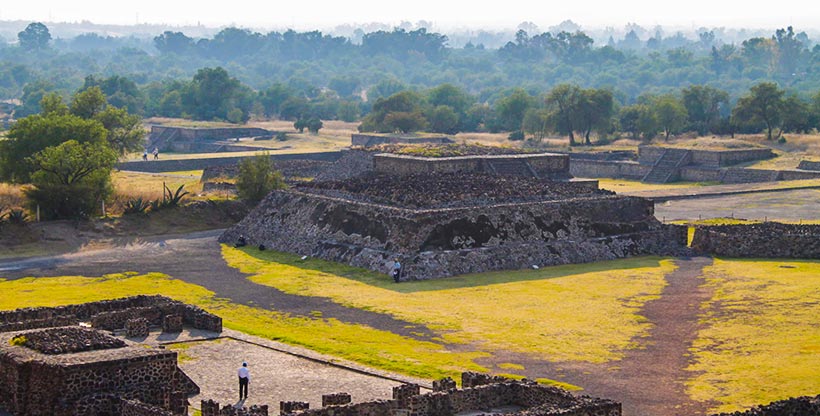
Taxes
As a U.S. citizen living in Mexico, you are still responsible for paying American taxes; however, you may be exempt if you meet certain requirements under the foreign earned income exclusion.
For example, if a U.S. citizen is in a foreign country for 330 days (about 11 months) or more in a consecutive 12-month period, the first $112,000 of the taxpayer’s income is tax-free. For details on your particular situation, check the IRS’ website for international taxpayers.
Housing
Many seasoned expats recommend renting first if you just moved to Mexico, to “test drive” an area and discover what suits you best. Explore your options without a long-term commitment, and take time to get acquainted with the local real estate market.
Buying Property in Mexico
When you’re ready to buy, there’s good news! You don’t need to be a resident or citizen to purchase property. Foreigners of any nationality have many of the same real estate rights as a Mexican national with one caveat. Property ownership rules vary slightly in “restricted” zones which are defined as 31 miles within a shoreline and 62 miles from an international border. Foreigners must buy these properties through a “fideicomisos,” a bank trust. Outside restricted zones, foreigners can buy and own property with the same rights as a citizen.
Transportation
Like the U.S., transit options in Mexico vary by location. Research the area you want to move to and determine the best option for your needs. Travel guides, such as Lonely Planet, are a good resource, as they usually detail transportation by region and/or city.
Public transit
In recent decades, Mexico invested heavily in road infrastructure, which connected most major cities by bus network. Local buses also run, but expats should be aware that safety regulations are looser than in the U.S. Urban areas such as Mexico City have an inexpensive and well-developed public transit system in place which utilizes two rail systems—El Metro and Tren Ligero—plus a city bus service called Metrobus.
Bringing Your Vehicle from the U.S.
For some, this is the most cost-effective option. To import your vehicle, you’ll need:
- Driver’s license. While a U.S. license is accepted, it’s best to have an International Driver’s Permit with a Spanish translation. Learn how to get an international driver’s permit.
- Temporary Importation Permit which can be obtained online. Note: The permit is not required for travel to Baja California.
- Title and registration. Note: If you have an auto loan, you’ll need a notarized letter permitting you to take it outside of the U.S.
- Car Insurance for Mexico. As stated before, Mexican police may not honor American car insurance, so ensure your coverage is adequate to avoid risk of arrest or having your car impounded. If you have questions, reach out to our advisors who specialize in international coverage.
Those steps will get you over the border, but once settled, don’t forget to check the local registration rules for vehicles.
Buying a Vehicle in Mexico
This is a more practical solution for some expats moving to Mexico. To go this route, you’ll need: a passport, driver’s license, visa, and a document (such as utility bill) showing your Mexican address, and of course, car insurance.
What are Considered the Best Cities in Mexico for Expats?
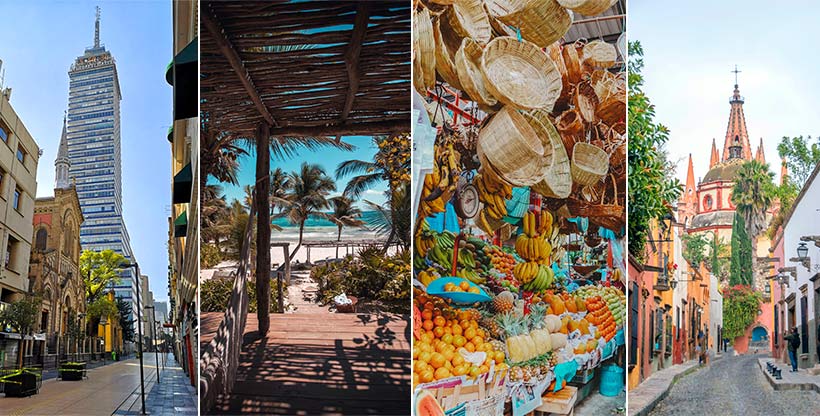
Now that we’ve addressed the paperwork, let’s talk about the fun part—imagining your new life in Mexico!
Consider what you prioritize in a lifestyle. Is it catching waves every day? A mild climate? Access to amenities such as public transit and museums? As stated earlier, these cities are widely considered the safest in Mexico, and each has their own unique vibe and allure.
1. Sayulita
A laid-back fishing village on Mexico’s Pacific Coast popular with digital nomads who surf both the web and the waves which are consistent, yet mild, making it a great place for beginners to hone their surfing skills. Puerto Vallarta with its nightlife and bustling beach resorts is just 30 minutes away, allowing you the benefit from Sayulita’s relaxed atmosphere without feeling isolated.
2. Puebla
Mexico’s fourth most populous city was named one of the top 10 places in the world to visit by travel authority National Geographic. Its colonial history and colorful architecture are an interesting contrast to spectacular natural scenery including the Popocatepetl volcano. Puebla also boasts world-class food and is the birthplace of two famous national dishes, mole and chile poblano.
3. Mérida
Capital of the Yucatán state, home to a large expat population, and widely considered the safest city in Mexico, Mérida has its fair share of historical sites from colonial history and much older ancient Mayan civilization, traces of which can still be seen today in the town’s festivals.
4. San Miguel de Allende
Located in Mexico’s central highlands, the climate is milder. Though there are plenty of visual remnants of the old world, including a towering pink neo-gothic church in the city center, San Miguel de Allende is a modern city with plenty of amenities for expats to enjoy.
5. Playa del Carmen
Just down the coast from crowded Cozumel, Playa del Carmen is a bit quieter with gorgeous sugar-sand beaches, coral reefs, and turquoise waters. At night, explore its famous Fifth Avenue, an area with active nightlife including dance clubs, restaurants, and shops.
6. Puerto Vallarta
This beach resort, set against the backdrop of the Sierra Madre mountains, is a paradise for water sports and marine life. Its economy is heavily reliant on tourists, so the locals are very welcoming and said to play a crucial role in discouraging crime.
7. Huatulco
If busy tourist hotspots aren’t your thing, Huatulco may be right for you. It has just enough amenities without being overdeveloped, and with nearly 40 beaches, it’s a paradise for sunbathers. River rafting and jungle hikes are also popular activities here.
8. Tulum
Tulum’s Mayan ruins are as much of a draw as its beaches. This area also offers natural wonders to explore such as underground rivers and cenotes, natural pools formed from sinkholes which are perfect for snorkeling.
9. Oaxaca
If authenticity is a priority, consider Oaxaca. Its preserved history and monuments earned it recognition as a UNESCO World Heritage Site. Also, Oaxaca is a foodie’s paradise, known for its broad array of cuisine, which you could learn to cook yourself at a local class with fresh ingredients from the city’s market.
10. Mexico City
This capital city is divided into 16 boroughs and has a well-developed public transit system. Like most cityscapes, many amenities are at your disposal including creature comforts, museums, and too many restaurants to count, along with a healthy dash of history which includes ancient shrines. If you tire of the urban life, take a day trip outside the city to attractions such as Tolantongo Caves.
The Best Way to Move to Mexico
Now that you’ve done the prep work, it’s time to move!
Should You Buy Goods in Mexico or Move Them?
Many expats recommend purchasing most of what you need, especially big-ticket items, at your destination. Shipping your household goods to Mexico is costly, not to mention a headache regarding Customs regulations. Even if you drive your own items to Mexico, importing your household goods requires much paperwork, including an extensive inventory and a certificate from the Mexican Consulate. Plus, you must already be a permanent or temporary resident, and if you are ever required to leave the country, you must take all your imported items back with you.
If you can’t live without certain items, hire a customs broker, a licensed expert familiar with importation law to help you navigate the paperwork properly. You may also consider renting a storage unit in the U.S. before you move to Mexico to hold items such as family photos, heirlooms, and important documents. We can help you cover the items left behind with a flexible international personal property insurance policy.
Overtourism
Traveling is one of life’s great pleasures, but too much of a good thing can have a negative impact. Overtourism is defined as “the phenomenon whereby certain places of interest are visited by excessive numbers of tourists, causing undesirable effects for the places visited.”
Mexico City has become one of the top destinations for digital nomads, and citizens have since experienced rent inflation and evictions, as locals are displaced to make room for affluent foreigners.
The answer is not to refrain from visiting, but rather, visit responsibly. Tourism stimulates the economy, but lack of tenancy legislation means visitors must assume the responsibility of ensuring their stay is ethical. The Good Guest Collective was formed in response to overtourism and consists of both Mexican and foreign nationals. Their goal is “help[ing] visitors be better guests.”
¡Buen Viaje!
We hope you have the adventure of a lifetime. Keep Clements in mind as a resource for planning your relocation from the U.S. to Mexico. We have been assisting Americans abroad since 1947 and are experts in international insurance coverage. Let us handle the logistics so you can safely enjoy this exciting new chapter in your life.
Speak to an advisor about insurance coverage in Mexico for U.S. expats.
Or reach us at: info@clements.com, +1.800.872.0067, +1.202.872.0060.